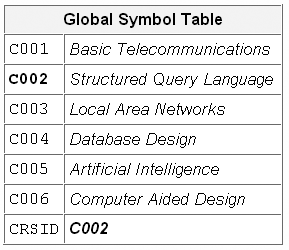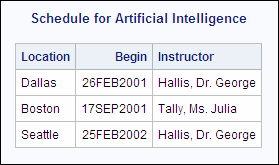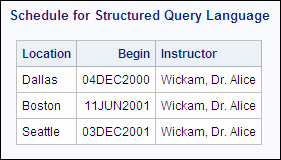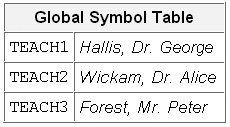Referencing Macro Variables Indirectly
Introduction
In the last example, you saw how
to use the SYMPUT routine to create a series of macro variables whose
names are based on the values of
Course_code.
However, you still needed to modify the TITLE statement in each PROC
PRINT step in order to print output for each course.
Suppose you want to
write a PROC PRINT step that you can reuse without any modification
to print information about each course. You can do this by using an
indirect reference in the TITLE statement.
data _null_;
set sasuser.courses;
call symput(course_code,trim(course_title));
run;
%let crsid=C002;
proc print data=sasuser.schedule noobs label;
where course_code="&crsid";
var location begin_date teacher;
title1 "Schedule for ???";
run;In the example above,
the macro variable
C002 (as created by the
SYMPUT routine) has a value of Structured Query Language.
Therefore, the TITLE statement should reference a macro variable that
resolves to Structured Query Language.
Remember that you want this reference to be flexible enough to apply
to any of the macro variables that the SYMPUT routine creates, such
as C003 or C004,
by changing only the %LET statement.
To obtain the value
Structured
Query Language, you need to indirectly reference the
macro variable C002 through a reference
to the macro variable crsid. If the value
of the macro variable crsid is C002,
then you need to proceed in several steps:
This sequence seems
to imply that you should use the reference
&&crsid to
convert the value of the macro variable crsid to
the corresponding course description. However, the Forward Re-Scan
rule indicates that this is not the correct solution.
The Forward Re-Scan Rule
The Forward Re-Scan rule can be summarized as follows:
-
When multiple ampersands or percent signs precede a name token, the macro processor resolves two ampersands (&&) to one ampersand (&), and re-scans the reference.
-
To re-scan a reference, the macro processor scans and resolves tokens from left to right from the point where multiple ampersands or percent signs are coded, until no more triggers can be resolved.
According to the Forward
Re-Scan rule, you need to use three ampersands in front of a macro
variable name when its value matches the name of a second macro variable.
This indirect reference resolves to the value of the second macro
variable.
Example
Suppose you want to
use the macro variable
crsid to indirectly
reference the macro variable C002.
The following table
shows several references along with their resolved values.
By preceding a macro
variable reference with two ampersands, you delay the resolution of
the reference until the second scan. The first time the reference
is scanned, only the double ampersands are resolved (to one ampersand).
In order to create an indirect reference (a reference whose value
is a reference to a different macro variable), you must use three
ampersands. Therefore, to use an indirect reference that resolves
to
Structured Query Language, the original
reference must be &&&crsid.
Example
You can use indirect
referencing to improve the last example. By using an indirect reference
to the macro variable whose name is the same as the current value
of the macro variable
crsid, you can write
a PROC PRINT step that you can reuse without modification in order
to print a report for each different course. options symbolgen;
data _null_;
set sasuser.courses;
call symput(course_code, trim(course_title));
run;
%let crsid=C005;
proc print data=sasuser.schedule noobs label;
where course_code="&crsid";
var location begin_date teacher;
title1 "Schedule for &&&crsid";
run;
%let crsid=C002;
proc print data=sasuser.schedule noobs label;
where course_code="&crsid";
var location begin_date teacher;
title1 "Schedule for &&&crsid";
run;The SAS log shows the
steps that lead to the resolution of these macro variables for each
PROC PRINT step.
43 options symbolgen;
44 data _null_;
45 set sasuser.courses;
46 call symput(course_code, trim(course_title));
47 run;
NOTE: There were 6 observations read from the dataset
SASUSER.COURSES.
NOTE: DATA statement used:
real time 0.07 seconds
cpu time 0.05 seconds
48
49 %let crsid=C005;
50 proc print data=sasuser.schedule noobs label;
51 where course_code="&crsid";
SYMBOLGEN: Macro variable CRSID resolves to C005
52 var location begin_date teacher;
SYMBOLGEN: && resolves to &.
SYMBOLGEN: Macro variable CRSID resolves to C005
SYMBOLGEN: Macro variable C005 resolves to Artificial
Intelligence
53 title1 "Schedule for &&&crsid";
54 run;
NOTE: There were 3 observations read from the dataset
SASUSER.SCHEDULE.
WHERE course_code='C005';
NOTE: PROCEDURE PRINT used:
real time 0.09 seconds
cpu time 0.04 seconds
55
56 %let crsid=C002;
57 proc print data=sasuser.schedule noobs label;
58 where course_code="&crsid";
SYMBOLGEN: Macro variable CRSID resolves to C002
59 var location begin_date teacher;
SYMBOLGEN: && resolves to &.
SYMBOLGEN: Macro variable CRSID resolves to C002
SYMBOLGEN: Macro variable C002 resolves to Structured
Query Language
60 title1 "Schedule for &&&crsid";
61 run;
NOTE: There were 3 observations read from the dataset
SASUSER.SCHEDULE.
WHERE course_code='C002';
NOTE: PROCEDURE PRINT used:
real time 0.06 seconds
cpu time 0.04 seconds |
This is the output from
the first PROC PRINT step.
This is the output from
the second PROC PRINT step.
Note that the PROC PRINT
steps that produced these reports were identical. Only the %LET statement
that precedes each PROC PRINT step and the resolved values of the
macro variables changed.
Indirect referencing
is especially useful when you are working with a series of related
macro variables. In
Introducing Macro Variables, you learned how to combine multiple
macro variable references in order to build new tokens. You can combine
indirect macro variable references with other macro variable references
as well. That is, you can use two ampersands in a reference when the
value of one macro variable matches part of the name of a second macro
variable.
Example
You can create a series
of macro variables,
teach1 to teachn,
each containing the name of the instructor who is assigned to a specific
course. options symbolgen;
data _null_;
set sasuser.schedule;
call symput('teach'||left(course_number),
trim(teacher));
run; Note: The concatenation operator
|| combines
text. In the example above, the literal string teach is
concatenated to the text that results from left-aligning the resolved
value of the variable Course_number.
Then, you can reference
one of these variables when a course number is designated. If you
designate a course number in a %LET statement, you can use multiple
ampersands in order to create a reference to the
teachn macro
variable that corresponds to the current course number. %let crs=3; proc print data=sasuser.register noobs; where course_number=&crs; var student_name paid; title1 "Roster for Course &crs"; title2 "Taught by &&teach&crs"; run;
The SAS log shows the
steps that lead to the resolution of the reference
&&teach&crs.
65 %let crs=3; 66 proc print data=sasuser.register noobs; 67 where course_number=&crs; SYMBOLGEN: Macro variable CRS resolves to 3 68 var student_name paid; SYMBOLGEN: Macro variable CRS resolves to 3 69 title1 "Roster for Course &crs"; SYMBOLGEN: && resolves to &. SYMBOLGEN: Macro variable CRS resolves to 3 SYMBOLGEN: Macro variable TEACH3 resolves to Forest, Mr. Peter 70 title2 "Taught by &&teach&crs"; 71 run; |
This is the output from
the example.
..................Content has been hidden....................
You can't read the all page of ebook, please click here login for view all page.






